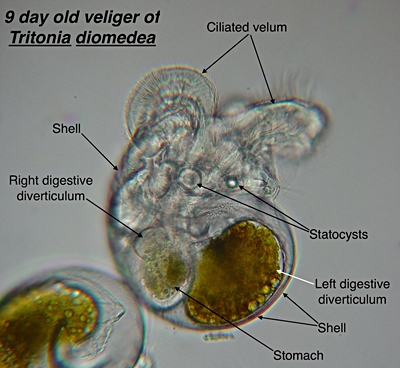
9-day-old veliger larva of a nudibranch (Tritonia diomedea, Nudibranchia). Picture: Stephen C. Kempf (Wikipedia).
The veliger larva is a typical developmental stage of many marine snails (and also some bivalves). After hatching from the egg capsule, these tiny, transparent larvae drift planktonically in open water.

9-day-old veliger larva of a nudibranch (Tritonia diomedea, Nudibranchia).
Picture: Stephen C. Kempf (Wikipedia).
The larva’s most striking feature is the velum – a pair of ciliated, sail-like lobes used for active swimming and feeding on plankton. During development, the larva begins to form a small, spirally coiled shell called the protoconch, and it gradually transforms toward its adult shape. Even shell-less adult sea slugs like nudibranchs still possess a shell at the veliger stage!
Eventually, the veliger sinks to the sea floor and metamorphoses into a benthic juvenile snail. Veliger larvae occur in many marine snail families, including cowries (Cypraeidae), cone snails (Conidae), and abalones (Haliotidae).
![]() Wikipedia:
Veliger (Larva).
Wikipedia:
Veliger (Larva).![]() Youtube-Video
by Alvaro Migotto:
Veliger - planktonic larva of many kinds of molluscs).
Youtube-Video
by Alvaro Migotto:
Veliger - planktonic larva of many kinds of molluscs).
![]() Bailey-Matthews National Shell Museum and Aquarium:
Cowrie Larvae Hatch at Museum!
Bailey-Matthews National Shell Museum and Aquarium:
Cowrie Larvae Hatch at Museum!